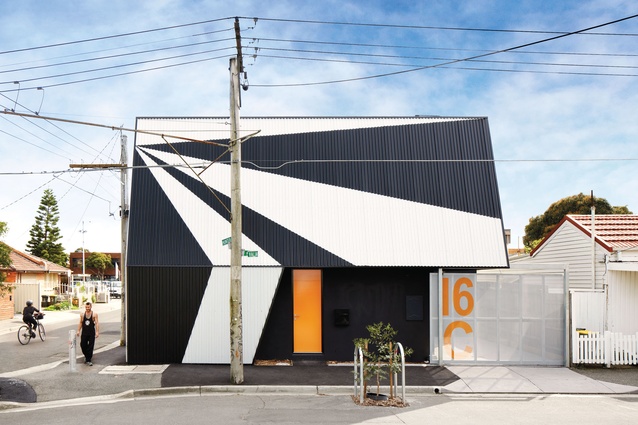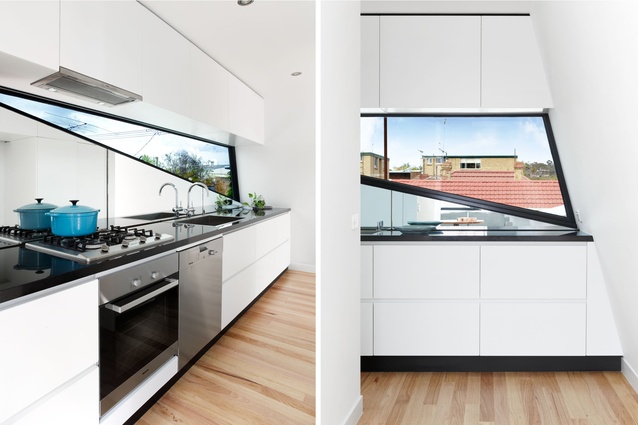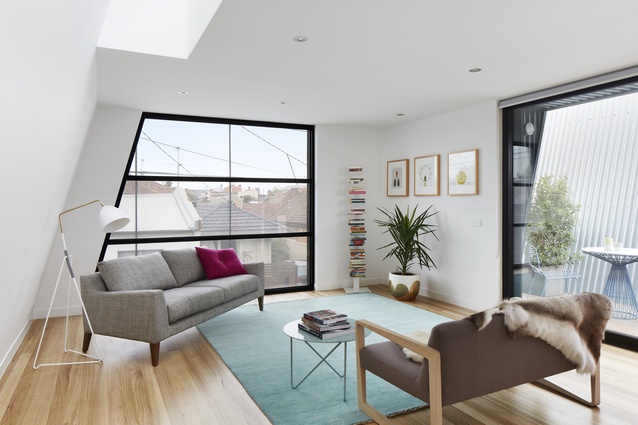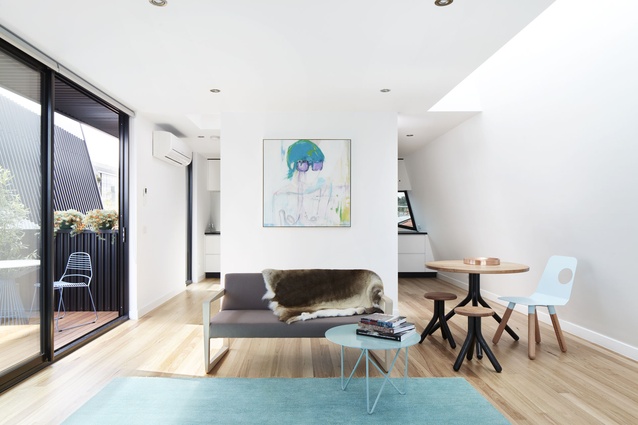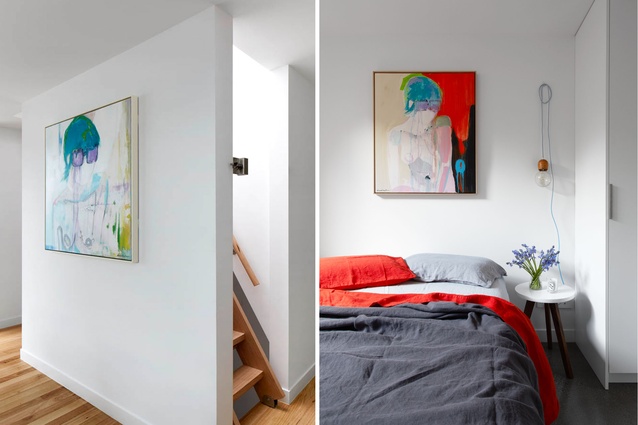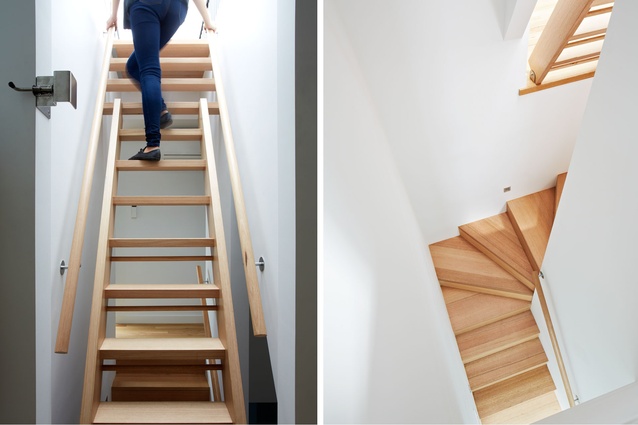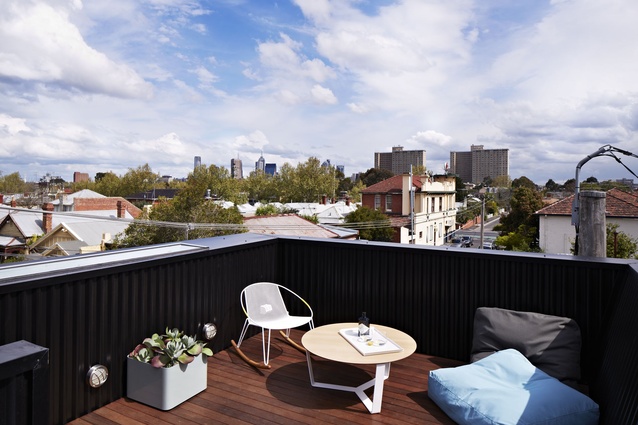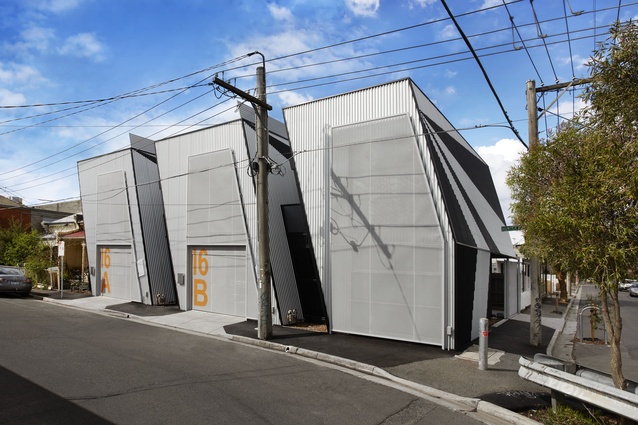Street life
Redeveloping a tight corner site in Melbourne’s central suburb of Abbotsford was always going to be a challenge. But ODR Architects’ John Mercuri and Steve McKellar embraced the opportunity to respond innovatively to a dense, urban setting.
“We looked at how the building’s architectural form might start to address the street corner in a similar way that the chevron pattern on a street sign does,” McKellar explains. “It became the point of departure for exploring what exactly that form could do.”
The process was stalled on a number of occasions as Mercuri and McKellar grappled with gaining planning approval from the local council. Abbotsford may have a mixed urban fabric but demolishing an existing 1970s’ cream-brick house to make way for the reinvented townhouse typology the architects were proposing was strongly opposed due to concerns the 239m² site would become over-developed if three townhouses were built. Approval finally came through in 2012 and construction was completed the following year.
From the street, the redevelopment presents as a dramatic sawtooth-like form clad in corrugated iron. The three townhouses have an industrial aesthetic, not unlike the existing warehouses in the area. However, the architects have been careful to differentiate them with modern detailing, such as over-sized house numbers and metal sun and privacy screens on the façades. The distinctly angular homes are emphasised by a graphic black-and-white exterior, which achieves its strongest expression on the southern elevation. Inspiration for the façades came from the work of Australian painter Jeffrey Smart.
“Smart, to us, celebrates the ordinary; things that are always there,” Mercuri says. “So we thought it appropriate for a project of this scale and for a design that deals with something that is ordinary to be informed by his work.”
The homes were always intended as investment properties and the 45-year-old owner currently rents them out on long-term leases. Although he allowed Mercuri and McKellar freedom with the design, there was one strict requirement in his brief: “Each townhouse had to have its own garage and that was the real difficulty in articulating the design in the way that we did,” McKellar explains. “Because car parking had to be onsite, it dictated how the programme would work.”
The resulting plan cleverly allows for larger upstairs living spaces by positioning the two bedrooms, study area and bathroom on the ground level along with the garage. This not only minimises the car parking spaces in the overall scheme but also lets as much natural light into the living spaces as possible. “Getting that sun into the kitchen, dining and lounge areas was critical, especially considering the compactness of the plan,” Mercuri says. “We didn’t want to replicate that classic, dark and dingy Victorian terrace.”
Of all three townhouses, the middle one is most likely to suffer from a gloomy interior but, just like the other two, it is elegantly light and modern. The irregularity of its form, characterised by a sloped southern wall, is what maximises sun penetration along with a generous skylight. But it is the dramatic windows – one shaped like a trapezium and the other like a triangle – on the first level’s west- and east-facing walls that lend the interior design its most compelling feature.
“The angled windows did result from trying to get more sun into the upstairs living spaces but we also wanted to add an unexpected element to the design,” says Mercuri. “Steve and I wanted to enliven the walls, so to speak, and use these non-traditional window forms to help define the space and connect the interior to the skyline beyond.” This has been achieved to great effect in the kitchen, where the triangular window slices through the splashback to reveal a lively inner-city mix of cable lines, rooftops and trees.
Framing each window in black aluminium contrasts with the white walls, providing a clean backdrop for contemporary furnishings. At approximately 155m², this townhouse may be slightly bigger than the one to its right but, nonetheless, a restrained approach has been taken with the interior. The pastel colour palette is reflected in a dove-grey couch from Jardan and baby-blue accents. Artworks by Melbourne-based artists David Band and Ali McNabney Stevens provide further pops of colour in the living area and master bedroom. Unsurprisingly, these abstract paintings were chosen for their ability to complement the interior’s materiality, in particular picking up on the rich tones of the flooring; polished concrete on the ground level and Tasmanian oak upstairs.
For both Mercuri and McKellar, the outdoor areas were crucial in achieving a desired sense of space. “There’s also a courtyard on the ground level, which provides good levels of sunlight for the bedrooms,” McKellar says. “But it was fairly obvious early on that a roof deck would have to come into play if we intended any reasonable amount of open space to be included.”
The roof deck succeeds in providing a rare oasis in an otherwise high-density urban environment and serves as a metaphor for the entire project which, essentially, does the same. In creating the three homes, Mercuri and McKellar have taken a typology as familiar as a Victorian townhouse, rendered it almost unrecognisable and turned it into something extraordinary and unexpected.
For an interview with the architect, click here.

